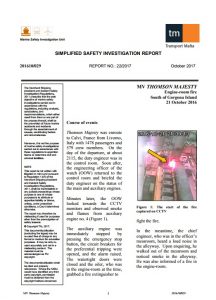Transport Malta’s Marine Safety Investigation Unit (MSIU) issued an investigation report regarding the engine room fire onboard the cruise ship ‘THOMSON MAJESTY’ in South of Gorgona Island, on 21 October 2016.
The incident
Thomson Majesty was enroute to Calvi, France from Livorno, Italy with 1478 passengers and 579 crew members. On the day of the departure, the OOW looked towards the CCTV monitors and observed smoke and flames from auxiliary engine no. 4. The auxiliary engine was immediately stopped by pressing the emergency stop button, the circuit breakers for the preferential tripping were opened, and the alarm raised. The watertight doors were closed and the oiler, who was in the engine-room at the time, grabbed a fire extinguisher to fight the fire.
In the meantime, the chief engineer, who was in the officer’s messroom, heard a loud noise in the alleyway. Upon enquiring, he walked out of the messroom and noticed smoke in the alleyway. He was also informed of a fire in the engine-room. The chief engineer rushed to the engineroom, where he observed that auxiliary engine no. 4 had been stopped whereas the three other auxiliary engines were still running. Taking stock of the situation, the chief engineer informed the master of the fire and status of the engine-room. The chief engineer requested that the fuel oil feed and booster pumps for auxiliary engine no. 41 and the ventilation fans are stopped, and fire flaps closed. In the meantime, within 19 seconds, the fire had become more
intense, the smoke was more dense and visibility was significantly reduced.
The engine-room fire squad had also assembled under the supervision of the chief engineer. Within a few minutes of the assembly of the fire squad, the fire was brought under control and extinguished with the use of portable fire extinguishers. Due to the fire, the rubber bellows fitted on the cooling water line in way of auxiliary engine no. 4 was damaged and leaked heavily. Consequently, before the crew members could identify and rectify the
problem, the cooling water expansions tanks leaked dry and the running auxiliary engines shut down automatically due to the activation of the fresh water high temperature alarm at about 2200. The situation was, however, alleviated with the automatic starting of the emergency generator.
Subsequently, the damaged bellows was replaced, the system replenished, and purged from air. Power was restored at about 0200 on 22 October 2016 and the vessel returned to Livorno with two auxiliary engines and two main engines running. No injuries had been reported.
Probable cause
The engineers had carried out maintenance on the auxiliary engine on the day of the fire. Maintenance records indicated that the main fuel oil supply and return lines had been dismantled and replaced with new pipes. The fuel lines were fitted in close proximity of the fire seat and therefore the initial
inspection of the crew members was directed towards that area.
When the fuel oil return pipe was disconnected from the high pressure pump on unit no. 6, it was observed that the O-ring was damaged. The pipe was located very close to the turbocharger and the aft exhaust gas manifold. It was therefore confirmed that the fuel oil leak had originated from the fuel oil return pipe because of the damaged O-ring.
Actions taken During the course of the safety investigation, the Company issued a Fleet Circular, outlining the following: Further details may be found in the following report:






























































